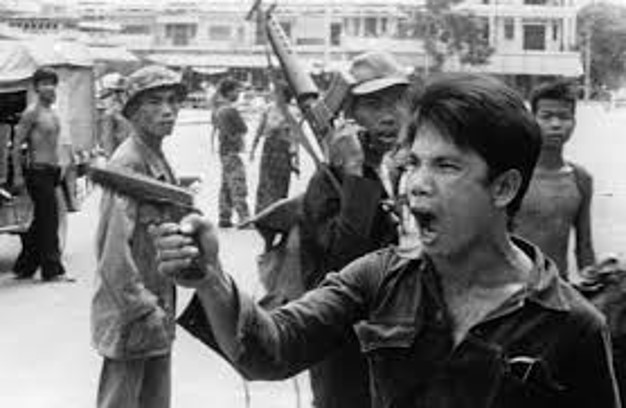Hun Manet, son of Hun Sen the Prime Minister of Cambodia, will step into the role of Prime Minister on August 22nd this year. Manet is 44 years old.

How can I make sense of this transition? The only time I met Hun Sen face to face he was very young. I heard him say, ‘If I was not causing bloodshed there would be more bloodshed’. He was a young man then. I was convinced that he believed this at the time. A biographer wrote of Hun Sen as, ‘Strong Man of Asia’. Now Hun Sen asserts that he has restored peace to his nation. Is he holding to enough power to come back into leadership if necessary?

Prime Minister Hun Sen has announced his retirement from leadership after more than thirty-eight years in office. His time in power began as the Khmer Rouge were driven back. Others who led the nation through turbulent times. and by stern means are also stepping back, though not completely away, from the center of influence. Among these are quite a few who are making space for their sons or daughters. The world has watched as these aging men whose tactics were forged in times of violence. They held to power decade after decade.
By contrast Hun Manet experienced a sheltered childhood and tertiary education in the USA and UK. He has a PhD in economics.
Hun Sen is quoted as saying that he is relinquishing his leadership reluctantly and gradually to avoid ‘turbulence’. He will remain a Member of Parliament, President of the ruling party and probably President of the Senate. He announced that he wants to promote a culture of dialogue between the government and the representatives of all the political parties that failed to gain a seat in Parliament. Ne will head the committee to choose the next King.
Time and again in the years since I first lived in Cambodia, I have seen brutal retaliation against any dissent. Once I questioned Nee, a close and trusted friend, about such things. I remember that he responded with words like this: ‘When Hun Sen was a young man someone put an AK47 in his hand and said, ‘We will need to kill a lot of people before we can have peace’. When I was a young man, and my father was being starved to death in front of us, he said, ‘Son, when this is over our country will need healers’.

Way back in 1993 Nee asked me to write in English his story of the great suffering of his country, and his thoughts about the way forward. On a shonky early laptop, I typed, all that I heard, week after week after week.
Scattered sentences that touched the heart of the matter are etched in my memory:
In the Khmer Rouge time trust was systematically destroyed. All of the respected people in our village were singled out for betrayal. Our life narrowed, narrowed to think only of survival. During those terrible years of Pol Pot time our minds were numb and paralysed, not capable of thinking much at all. I remember clearly what hunger is like, I was only 18 years old. There was no hair on my head, my knees were weak and would not obey me when I needed to walk. I was blind in the dark and so when I set out for my work at 3am and returned at 8pm I would have to be led along holding on to the hoe of the person in front. My memories of that time are of numbness and of trying to stay alive, never to think. You cannot easily change the damage caused by the war, or caused by the systematic breaking of relationships, or the loss of human dignity. We need to know this and to know that people will eventually pass beyond that stage. It is a matter of rebuilding spirit, life and relationships. ‘Son when this is over our people will need healing’.

There were seventy-one pages typed in very small print. We wondered whether these pages might be enough for a small book.
The editor of the Phnom Penh Post, an Australian, encouraged us to set up Nee’s book on the PPP office machinery, then to design a cover and give it a name. It needed a Cambodian image for the cover. Kike gave us one.
The First edition of Towards Restoring Life was printed in July 1994. It sold out fast.
The Japan Sotoshu Relief Committee (JSRC) whose motto is ‘One Book Can Inspire Thousands’ printed a second edition of Towards Restoring Life in 1995 and a third in early 1996.
Later the Australian Overseas Service Bureau, now known as Australian Volunteers International published Towards Restoring Life with ISBN and held a book launch in Fitzroy.
In Cambodia the book was sold in the markets and on the streets. Enterprising hawkers would photocopy multiple copies of Towards Restoring Lifethen sell the copies for the price of the original. Nee said, ‘We didn’t produce this book to make money. We just want people to read it and think about it’.
Very soon after the first publication the book was translated, with Nee’s permission, into French and Japanese. Then with Nee’s help it was available in Khmer
After that it found its own way to places where people identified with a story reflecting their own. It was, as we found later, translated and published or circulated in Thai, Vietnamese, Bahasa Indonesia, and Tetum. It reached, perhaps in the Thai edition, into the north of Myanmar. A lecturer from Darwin University contacted me; they could incorporate it into a course they were offering. The First Peoples of Australia had also suffered the torment of powerlessness.

This year while I was in Cambodia something remarkable happened. I met an international volunteer in a Cambodian university. She told us that a large amount of money changed hands for an early edition of Towards Restoring Life,
‘One Book Can Inspire Thousands.’
